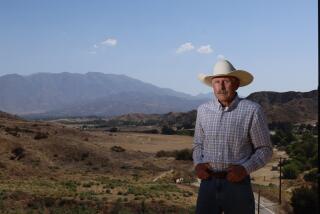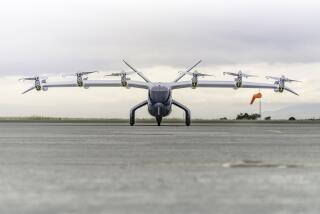Roberts Outlines ‘TwinPorts’ Plan for New Airport : Aviation: Border facility would share runways and air traffic control with Tijuana’s airport but terminal facilities would be kept separate.
- Share via
In a new effort to end San Diego’s long-running debate over its airport needs, City Councilman Ron Roberts on Wednesday proposed building an international airport on Otay Mesa that would share runways and a control tower with Tijuana’s existing airport.
Dubbed “TwinPorts,” Roberts’ proposal calls for a 12,000-foot runway and terminals to be built on the U.S. side of the border, adjacent to Tijuana’s international airport.
The twin airports would operate separate arrival and departure terminals, customs checkpoints, immigration, agriculture and other inspection facilities. The only permanent physical feature crossing the border would be a taxiway linking the two parallel runways.
“This plan could help to finally move this lengthy debate over the airport forward,” said Roberts, whose council district encompasses Lindbergh Field. Since his 1987 election, Roberts, an architect by profession, has focused extensively on the long-debated plans to expand or replace Lindbergh Field--which, because of its single runway, is nearing capacity.
A variation of earlier proposals to build a jointly run binational airport on Otay Mesa, Roberts’ plan--which he is scheduled to formally present to the council at a meeting today--would cost an estimated $1.5 billion to $2 billion.
Under a “very optimistic scenario” that envisions relatively smooth approval by the various local, federal and Mexican authorities that would review it, the TwinPorts facility could be operational by the turn of the century, Roberts said.
If the TwinPorts plan were enacted, Lindbergh Field would remain open, operating at roughly its present capacity, primarily as a short-haul and commuter service airport. Brown Field, a small city-owned airport on Otay Mesa, would be closed and its operations shifted to the new border airport.
Emphasizing that the TwinPorts plan incorporates concepts from earlier airport expansion proposals developed over more than two decades of inconclusive civic debate, Roberts argued that it “solves some of the political and physical problems that prevented” those previous schemes from getting off the ground, literally as well as figuratively.
By allowing each nation to maintain separate terminals and other facilities, for example, questions about potential immigration and customs problems have been minimized, Roberts said.
Air traffic controllers could direct planes to either runway for takeoffs and landings. After landing, planes would then taxi to the appropriate terminal.
Another stumbling block to previous suggestions for a jointly operated binational airport involved the Mexicans’ dissatisfaction over its proposed location on the U.S. side of the border.
“What they said was, ‘You call it a binational airport, but it looks pretty much like a gringo airport to us,’ ” said Michael Abrams, an aide to Roberts. That complaint has been alleviated, however, by preserving Rodriguez Field, the Tijuana airport’s official name, and making it an integral part of the proposed TwinPorts facility.
In addition, the proposed configuration of the U.S. runway would address safety concerns raised over the prospect of placing a large international airport on Otay Mesa, west of 3,572-foot Otay Mountain. A preliminary study showed that an east-west runway built parallel to Rodriguez’s existing runway would remove aircraft from the mountain’s direct path, Roberts explained.
“Some of my colleagues have been critical because the plan keeps changing,” Roberts said. “But one thing I learned as an architect is that you modify your plans to reflect what you learn as you go along, and that’s what we’re doing here. This plan is better because it builds upon the ones that went before it.”
At the Uptown news conference where Roberts unveiled his proposal, representatives of the Airlines Pilots Assn., local business leaders and others praised the TwinPorts idea.
“This is the first breath of fresh air in five years of discussion of San Diego’s airport needs,” said Capt. Tom Carrol of the Airline Pilots Assn., adding that his organization has given its “stamp of approval” to the plan.
Noting that the Greater San Diego Chamber of Commerce also has conceptually endorsed the project, Chamber President Lee Grissom added: “This may be our last really good chance to provide adequate air facilities.”
Mexican officials, too, have been receptive toward the proposal, said Roberts, who has made numerous trips to Mexico and Washington promoting the concept. Neither government, however, has officially signaled its endorsement of the plan yet.
Debate over the future of Lindbergh Field has been a staple of San Diego’s political agenda since the 1960s. With Lindbergh’s physical limitations severely restricting its potential expansion--the 475-acre facility is boxed in by downtown growth and the Marine Corps Recruit Depot--city leaders have long recognized the eventual necessity of constructing a second major airport.
In recent years, the search for possible sites for a second local airport has largely narrowed to the Miramar Naval Air Station and Otay Mesa--areas attractive primarily because of their ready availability of the hundreds of vacant acres needed for such a project. The American portion of the TwinPorts proposal, for example, would require about 1,500 acres, Roberts said.
From the Navy’s perspective, however, Miramar’s possible use as a civilian airport is inconsistent with the base’s critical military role. With Navy leaders being unwavering on that point, Otay Mesa increasingly has been looked to as perhaps the most viable remaining option for keeping San Diego’s major airport relatively close to the city’s core.
Beyond the safety questions, the other major objection raised about Otay Mesa’s feasibility in the past--arguments certain to be repeated during debate over Roberts’ proposal--focuses on the fact that placement of an airport there would preclude long-range plans for industrial and residential development in the area.
Roberts argued Wednesday, however, that the proposed TwinPorts site--property now largely vacant, with a sprinkling of industrial facilities--is surrounded by hundreds of empty acres “going nowhere fast.” Construction of an airport there, he adds, could galvanize development and create hundreds of jobs providing support services for the airport.
“A lot of politicians talk about creating jobs, and many of them talk about creating them in the South Bay,” Roberts said. “There isn’t anything this city could do that would create more jobs in the South Bay than to build this airport.”
To preserve the city’s options, Roberts said that he will encourage his council colleagues to adopt land-use restrictions prohibiting the kind of interim development in the border region that could pose later obstacles to an airport.
As much as 35% of the project’s estimated $1.5-billion-plus cost could be financed with federal funds, Roberts said. Though that would leave the city facing at least a $1-billion price tag, Roberts argued that the sale of Brown Field could bring as much as $500 million, adding that landing fees and added tax revenues from the development spawned by a new airport would easily cover the remaining cost.
“This would not be a drain on city taxpayers,” Roberts said. “If anything, this would be a huge revenue generator for the city.”
The proposed TwinPorts airport also could enhance San Diego’s access to Pacific Rim nations, which in turn could pay major financial dividends, Roberts added. Because of their shorter runways, neither Lindbergh Field nor Tijuana’s airport can accommodate the jumbo jets with full fuel loads that fly nonstop international routes to Asia, Europe or South America.
“This truly would be a major step into the 21st Century for San Diego,” Roberts concluded.
More to Read
Sign up for Essential California
The most important California stories and recommendations in your inbox every morning.
You may occasionally receive promotional content from the Los Angeles Times.










